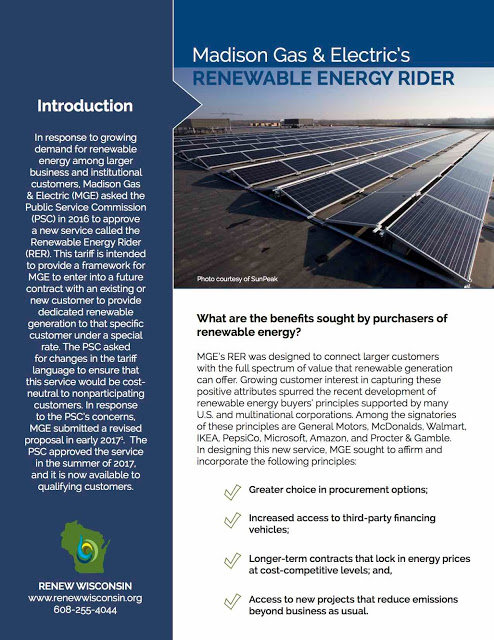
Madison Gas & Electric’s “Renewable Energy Rider” Ready for Action
Madison Gas & Electric is now offering a first-in-Wisconsin opportunity for its business and institutional customers to access clean, renewable energy.

Madison Gas & Electric is now offering a first-in-Wisconsin opportunity for its business and institutional customers to access clean, renewable energy.
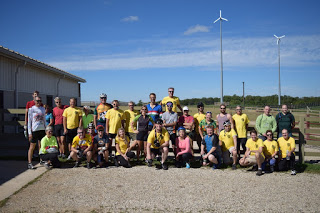
“Ride with RENEW” will highlight area renewable energy projects
Madison, WI – August 23, 2017; Contact Tyler Huebner, Executive Director, 608-255-4044 ext 1.
On Sunday, October 1st, RENEW Wisconsin, with presenting sponsor SunPeak, will host its 5th annual “Ride with RENEW” bicycle tour of renewable energy projects, with this year’s ride taking place in Middleton, WI. All event proceeds support RENEW Wisconsin’s ongoing work to advance renewable energy in Wisconsin.
Riders will travel approximately 22 miles on paved roads and bike paths to visit innovative wind, solar and biogas energy generation facilities in scenic northwest Dane County.
 |
| 2015 Ride with RENEW – Lake Geneva |
The total tour time will be approximately 6 hours (including stops at renewable energy sites) and actual riding time will be 2 to 3 hours. Seasoned cyclists will have an optional longer route of about 40 miles to travel at their own pace.
Participants will get an inside look at some of the area’s leading renewable energy projects and will enjoy breakfast, lunch, and beverages along the way. They will visit with installers and workers who are advancing renewable energy every day, and hear from customers about why clean energy works for their pocketbooks and their businesses.
The stops and start and end schedule is as follows:
∞ Gather at BMO Harris Bank parking Lot in Middleton for a 9:30 a.m. departure.
∞ Sustainable Engineering Group’s net-zero solar powered office in downtown Middleton.
∞ Gundersen Health Systems & Dane County Biodigester. This project converts manure to make enough electricity to power approximately 2,500 homes while keeping manure out of the watershed.
∞ Madison Gas & Electric’s Middleton Shared Solar project, a large 500 kilowatt solar project on the roof of the Middleton Operations Center. Subscribers to this pilot shared solar program receive the benefits of locally generated solar power from a centralized solar project.
∞ Epic’s “Galactic” Wind Farm, featuring six turbines — each with three 135-foot blades – which rise hundreds of feet above the rolling hills northwest of Madison and generate enough electricity to help Epic offset much of its energy needs.
∞ PDQ in downtown Middleton. Presenting sponsor SunPeak installed solar panels on this store which showcases the market advances of solar alongside traditional fuels.
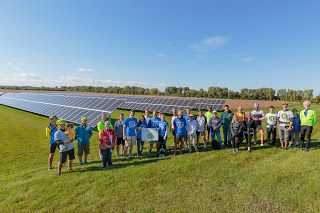 |
| 2016 Ride with RENEW – Sisters of St. Agnes Solar Array in Fond du Lac |
The ride will conclude at Capital Brewery, also powered by a set of solar panels, for refreshments around 4:00 p.m.
Registration for the ride is open through September 29th. The cost is $30 for members of RENEW Wisconsin, $40 for non-members, and $60 to both register for the ride and become a member of the organization for one year. All donations to RENEW Wisconsin for this charity bike ride are matched up to $15,000 by generous donors John & Mary Frantz of Madison!
Individuals and businesses can donate to RENEW Wisconsin or in support of a rider, sign on as an event sponsor, or volunteer on ride day.
“We are very excited to tour some of the Middleton area’s great renewable energy projects on Sunday, October 1st,” said Tyler Huebner, Executive Director of RENEW Wisconsin. “This tour allows us to showcase a variety of ways to produce homegrown, clean energy right here in Wisconsin including wind, solar, and even cow manure. This is a really fun event where you can meet great people, help a good cause, and learn together about clean energy in Wisconsin.”
Sponsors of the Event include SunPeak (presenting sponsor), Capital Brewery, City of Middleton, H&H Solar, Summit Credit Union, Wegner CPAs, Full Spectrum Solar, One Energy Renewables, Midwest Solar Power, Madison Solar Consulting, Open Circle UUF, and Willy Street Co-op. There is still time to sponsor if your business or organization wishes to do so.
About RENEW Wisconsin
RENEW Wisconsin is a nonprofit organization which promotes renewable energy in Wisconsin. We work on policies and programs that support solar power, wind power, biogas, local hydropower, and geothermal energy. More information on RENEW’s website: www.renewwisconsin.org.
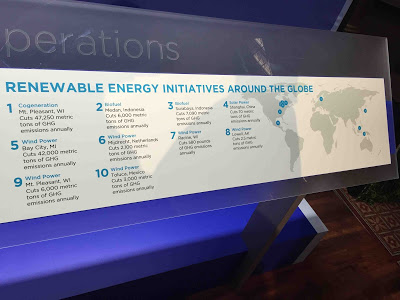
On May 14th, Racine, WI-based SC Johnson was honored by the World
Environment Center as the recipient of the 2015 Gold Medal for International
Corporate Achievement in Sustainable Development.
 |
| SC Johnson’s global renewable energy initiatives poster |
With financial support from SC Johnson, I attended the event
in Washington, DC to help honor the company.
RENEW’s relationship with SC Johnson started about four years ago, when our
Program and Policy Director Michael Vickerman advised the company as it was
pursuing the installation of two wind turbines to help power Waxdale, one of
its major factories in Mt. Pleasant, Wisconsin, near Racine.
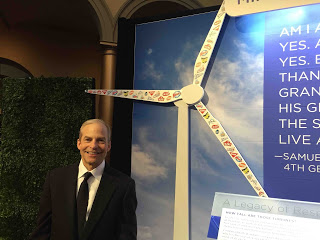 |
| CEO Fisk Johnson proudly supporting clean energy |
Fisk Johnson, the 5th generation CEO of the family-owned
company, was on hand to receive the award.
“Reaching for that ideal of trust and goodwill is what motivates us at
SC Johnson, and it’s where we find our best answers and greatest
successes. This recognition today, which
I accept with great pride on behalf of all of the people in our company,
inspires us on even more.”
According to SC
Johnson, Waxdale produces an average of 100 percent of its electrical energy
onsite each year. Glade®,
Windex®, Pledge®, Scrubbing Bubbles®, Shout®, Raid® and OFF!®
are all among the trusted household products made at Waxdale.
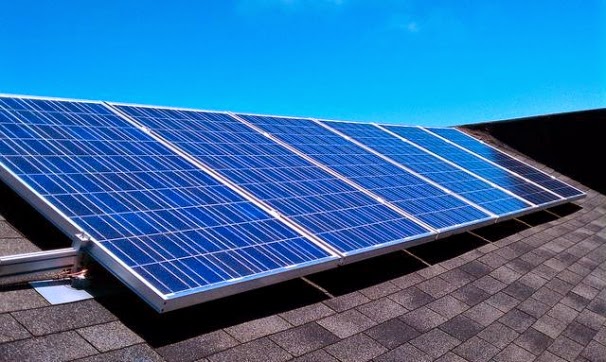
“The Public Service Commission’s own staff expert testified that there was not enough evidence in the record to approve the discriminatory solar charges,” said Amy Heart, spokesperson for The Alliance for Solar Choice. “That will be difficult to deny in the courts.”
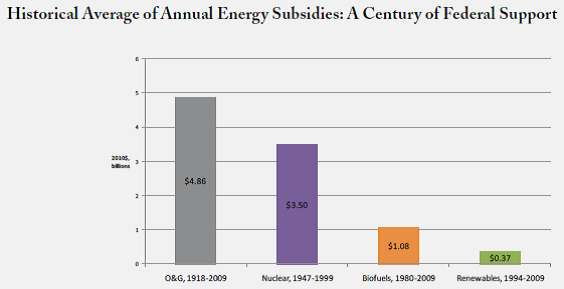
by Don Wichert, RENEW Wisconsin
1. Renewable energy is cost effective with conventional fossil and nuclear fuels
The price of renewable energy continues to decline, while the price of conventional energy (with the recent exception of natural gas) continues to increase. Customer-sited solar electric is now equal to or less than the retail cost of grid electricity in many areas of Wisconsin. Dairyland Power Cooperative and Vernon Electric Cooperative will begin purchases of power from two large solar arrays under long term contracts. Biogas to electricity is competitive or less than retail electricity for farms and solid biomass fuels out compete propane and oil in rural areas. Renewable fuels have stable, zero, or low fuel costs, that do not fluctuate like fossil fuels.
2. Fossil and nuclear industries have received more subsidies from government than renewables
All energy production in the U.S. receives significant federal support, dating back to the first oil subsidies in early 20thcentury. In cumulative dollar amounts, the oil, coal, gas and nuclear industries have received approximately $630 billion in U.S. government subsidies, while wind, solar, biofuels and other renewable sectors have received a total of roughly $50 billion in government funding.
(DBL Investors, http://bit.ly/uV14lf)
3. Wisconsin has plenty of solar energy
Wisconsin consistently receives enough solar energy to supply significant amounts of electricity used in Wisconsin households and businesses from their rooftops and properties. Wisconsin receives 20 percent more solar energy than the world’s leader in solar development, Germany, and similar amounts as New Jersey, a solar energy installation’s leader in the US. A number of studies imply that solar could supply 100 percent of Wisconsin’s electricity during peak hours by installing panels on existing roofs with solar access (http://www.ecotopia.com/apollo2/photovoltaics/PVMktPotentialCostBreakthruNavigant200409.pdf).
4. Renewable energy provides energy at critical times and locations and is matched well with other resources to maintain reliability
Solar energy output peaks in the summer when demand on the electricity system is highest due to air conditioning use. Wind power can also match high electrical demands when summer and winter winds bring in heat and cold. Biomass and hydropower are forms of stored solar energy that can be used to fill in supply gaps from intermittent sources. Natural gas plants can be quickly started as an adequate and clean back up source of power. Renewable energy systems can be installed at weak voltage locations in the transmission grid to boast power. Installation of incremental amounts of renewable energy to meet growing local demand can occur in months rather than in the years it takes for fossil fuel plants to be installed.
5. Net metering adds value to the grid and all customers
Net metering uses the electric transmission grid to absorb extra renewable electricity from distributed producers and provides a similar amount of electricity back when electric demand exceeds renewable supply. Net metering adds value when produced during peak electrical demand hours, reduces the need for transmission and distribution infrastructure, reduces environmental emissions, enhances energy security, and hedges the variable nature of fossil fuels prices. Although all customers pay for the electrical grid, studies have shown that the extra value from the renewable production is greater than the cost.
6. Wind power provides local energy, improved environmental & economic impact
Wisconsin has thirteen wind farms varying in size from 1.3 MW to 162 MW with a total of 647 MW. This represents about half of all wind energy used in Wisconsin, the rest coming from neighbors Iowa and Minnesota. This power is local, has no emissions, and is now one of, if not the, lowest sources of electricity in Wisconsin and the Midwest (http://www.awea.org/Resources/Content.aspx?ItemNumber=5547).
7. Biogas takes pollution and converts it to rural energy, jobs, and environmental improvements
Wisconsin’s 1.3 million dairy cows produce a great deal of manure: 16 billion gallons per year. For years this manure was spread on pasture land in the summer and winter. Unfortunately, some of the nutrients, pathogens, and smell polluted the local water and air sheds. Wisconsin’s 40-50 farm and food bio digesters take manure and high organic content food wastes and convert these pollutants to local energy, fertilizer, high value bedding, while reducing pathogens and smell by over 95 percent (http://www.epa.gov/agstar/documents/gordondale_report_final.pdf). In addition, the remaining digestate, which is the liquid left over from the digesters, can be stored and used in irrigation systems to add water and nutrients to crops at optimal times.
8. Biomass energy reduces greenhouse gas and other emissions, and can be grown sustainably
Biomass is “young” stored solar energy. Through photosynthesis, water is combined with carbon dioxide to form hydro-carbon compounds. Depending on the biomass, the stored carbon is one to 100 years old. In a natural system of growth and decay, all of the biomass would eventually go back to the atmosphere as carbon dioxide or methane as the biomass oxidizes (rots), if not used. Converting the biomass for productive energy reduces the total carbon emissions because it replaces old (fossil) carbon that has been stored in fossil fuels for millions of years. In addition, half of a tree’s mass is in the roots and some of the carbon is taken up by surrounding soils and stored there.
The vast majority of modern biomass combustion units are labeled, highly efficient, and are regulated for air emissions. This includes residential wood stoves. Most biomass energy processes only use wastes from non-energy forest or crop applications. Smaller branches, twigs, and leaves are not taken for energy use and contain most of the nutrients, which are recycled into the soils on the forest floor. Residual ash from the combustion process, which contains valuable nutrients, can be reapplied to the land.
9. Renewable energy is becoming more mainstream everyday
In 2012 and 2013 solar and wind supplied 51% and 37%, respectively, of all new electric generation capacity in the US (wind power additions fell in 2013 as a result of the expiration of the production tax credit).
Renewable energy now produces more power than nuclear energy in the US.
Solar energy grew at a 40% rate in 2013 from 2012. Wind energy has over 60,000 Megawatts of installed capacity, a ten-fold increase from 10 years ago.
10. The vast majority of Wisconsin citizens want more renewable energy
Surveys consistently show that Wisconsin citizens prefer renewable energy over fossil fuels. Over 83% of Wisconsin voters support solar, wind, and hydro as their energy source vs about 50 percent for coal and nuclear (Source: Voter attitudes towards Energy Issues in Wisconsin, 2012).